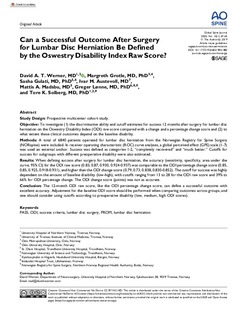| dc.contributor.author | Werner, David Andreas Thomas | |
| dc.contributor.author | Grotle, Margreth | |
| dc.contributor.author | Gulati, Sasha | |
| dc.contributor.author | Austevoll, Ivar Magne | |
| dc.contributor.author | Madsbu, Mattis Aleksander | |
| dc.contributor.author | Lønne, Greger | |
| dc.contributor.author | Solberg, Tore | |
| dc.date.accessioned | 2020-02-27T08:45:08Z | |
| dc.date.available | 2020-02-27T08:45:08Z | |
| dc.date.created | 2020-02-24T15:38:53Z | |
| dc.date.issued | 2019 | |
| dc.identifier.citation | Global Spine Journal. 2019, 10 (1), 47-54. | nb_NO |
| dc.identifier.issn | 2192-5682 | |
| dc.identifier.uri | http://hdl.handle.net/11250/2644093 | |
| dc.description.abstract | Study Design:
Prospective multicenter cohort study.
Objective:
To investigate (1) the discriminative ability and cutoff estimates for success 12 months after surgery for lumbar disc herniation on the Oswestry Disability Index (ODI) raw score compared with a change and a percentage change score and (2) to what extent these clinical outcomes depend on the baseline disability.
Methods:
A total of 6840 patients operated for lumbar disc herniation from the Norwegian Registry for Spine Surgery (NORspine) were included. In receiver operating characteristic (ROC) curve analyses, a global perceived effect (GPE) scale (1-7) was used an external anchor. Success was defined as categories 1-2, “completely recovered” and “much better.” Cutoffs for success for subgroups with different preoperative disability were also estimated.
Results:
When defining success after surgery for lumbar disc herniation, the accuracy (sensitivity, specificity, area under the curve, 95% CI) for the ODI raw score (0.83, 0.87, 0.930, 0.924-0.937) was comparable to the ODI percentage change score (0.85, 0.85, 0.925, 0.918-0.931), and higher than the ODI change score (0.79, 0.73, 0.838, 0.830-0.852). The cutoff for success was highly dependent on the amount of baseline disability (low-high), with cutoffs ranging from 13 to 28 for the ODI raw score and 39% to 66% for ODI percentage change. The ODI change score (points) was not as accurate.
Conclusion:
The 12-month ODI raw score, like the ODI percentage change score, can define a successful outcome with excellent accuracy. Adjustment for the baseline ODI score should be performed when comparing outcomes across groups, and one should consider using cutoffs according to preoperative disability (low, medium, high ODI scores). | nb_NO |
| dc.language.iso | eng | nb_NO |
| dc.publisher | SAGE Publications | nb_NO |
| dc.rights | Attribution-NonCommercial-NoDerivatives 4.0 Internasjonal | * |
| dc.rights.uri | http://creativecommons.org/licenses/by-nc-nd/4.0/deed.no | * |
| dc.title | Can a Successful Outcome After Surgery for Lumbar Disc Herniation Be Defined by the Oswestry Disability Index Raw Score? | nb_NO |
| dc.type | Journal article | nb_NO |
| dc.type | Peer reviewed | nb_NO |
| dc.description.version | publishedVersion | nb_NO |
| dc.source.pagenumber | 47-54 | nb_NO |
| dc.source.volume | 10 | nb_NO |
| dc.source.journal | Global Spine Journal | nb_NO |
| dc.source.issue | 1 | nb_NO |
| dc.identifier.doi | 10.1177/2192568219851480 | |
| dc.identifier.cristin | 1797041 | |
| dc.description.localcode | This article is distributed under the terms of the Creative Commons Attribution-NonCommercial-NoDerivs 4.0 License (https://creativecommons.org/licenses/by-nc-nd/4.0/) which permits non-commercial use, reproduction and distribution of the work as published without adaptation or alteration, without further permission provided the original work is attributed as specified on the SAGE and Open Access pages (https://us.sagepub.com/en-us/nam/open-access-at-sage). | nb_NO |
| cristin.unitcode | 194,65,30,0 | |
| cristin.unitcode | 1920,16,0,0 | |
| cristin.unitcode | 1920,0,0,0 | |
| cristin.unitname | Institutt for nevromedisin og bevegelsesvitenskap | |
| cristin.unitname | Nevroklinikken | |
| cristin.unitname | St. Olavs Hospital HF | |
| cristin.ispublished | true | |
| cristin.fulltext | original | |
| cristin.qualitycode | 1 | |

